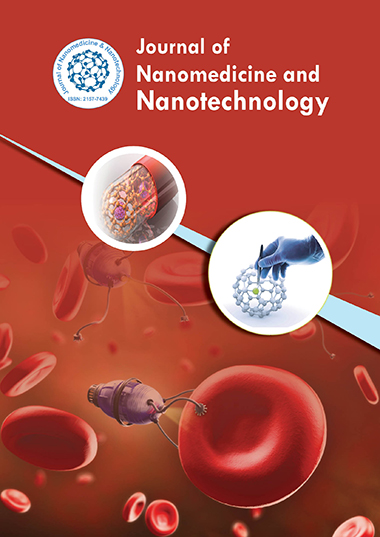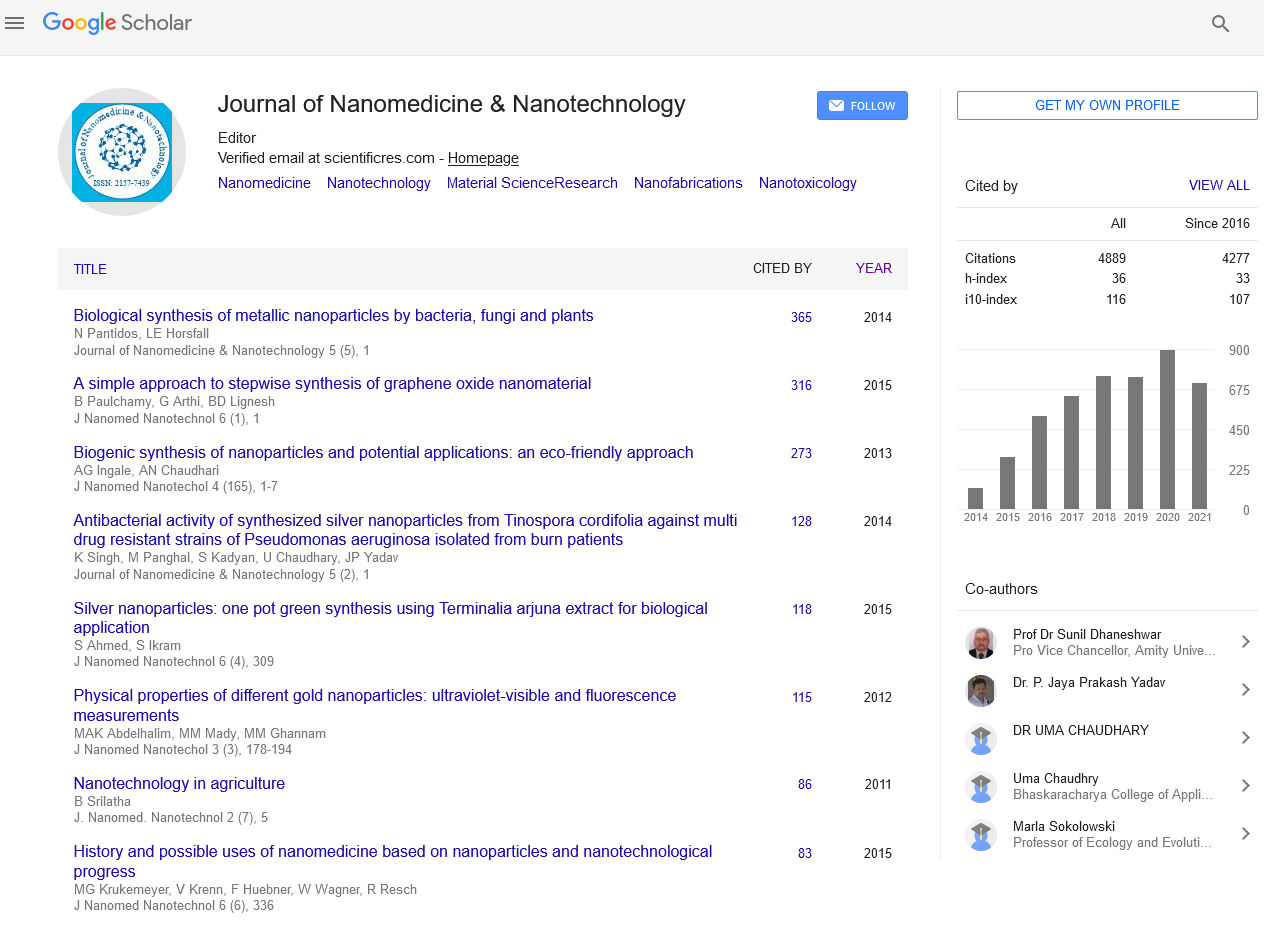Indexed In
- Open J Gate
- Genamics JournalSeek
- Academic Keys
- JournalTOCs
- ResearchBible
- China National Knowledge Infrastructure (CNKI)
- Scimago
- Ulrich's Periodicals Directory
- Electronic Journals Library
- RefSeek
- Hamdard University
- EBSCO A-Z
- OCLC- WorldCat
- SWB online catalog
- Virtual Library of Biology (vifabio)
- Publons
- MIAR
- Scientific Indexing Services (SIS)
- Euro Pub
- Google Scholar
Useful Links
Share This Page
Journal Flyer

Open Access Journals
- Agri and Aquaculture
- Biochemistry
- Bioinformatics & Systems Biology
- Business & Management
- Chemistry
- Clinical Sciences
- Engineering
- Food & Nutrition
- General Science
- Genetics & Molecular Biology
- Immunology & Microbiology
- Medical Sciences
- Neuroscience & Psychology
- Nursing & Health Care
- Pharmaceutical Sciences
Editorial - (2024) Volume 15, Issue 5
Biocompatibility and Safety of Nanocarriers: Challenges and Solutions
Lena Fischer*Received: 03-Sep-2024, Manuscript No. jnmnt-24-27135; Editor assigned: 05-Sep-2024, Pre QC No. jnmnt-24-27135 (PQ); Reviewed: 20-Sep-2024, QC No. jnmnt-24-27135; Revised: 24-Sep-2024, Manuscript No. jnmnt-24-27135 (R); Published: 30-Sep-2024, DOI: 10.35248/2157-7439.24.15.749
Abstract
The development of nanocarriers for drug delivery has revolutionized the field of nanomedicine, promising enhanced therapeutic efficacy and targeted action. However, concerns regarding biocompatibility and safety remain significant barriers to their clinical translation. This article reviews the current challenges associated with the biocompatibility and safety of nanocarriers, discusses the mechanisms of toxicity, and outlines strategies for mitigating risks. We highlight recent advancements in materials science, surface modification techniques, and regulatory frameworks aimed at ensuring the safe application of nanocarriers in medical therapies.
Keywords
Nanocarriers; Biocompatibility; Safety; Drug Delivery; Toxicity; Surface Modification; Regulatory Frameworks; Nanomedicine
INTRODUCTION
Nanocarriers are engineered nanostructures designed to encapsulate and deliver therapeutic agents efficiently. They have shown great promise in improving drug solubility, bioavailability, and targeted delivery, thereby enhancing therapeutic outcomes. However, the introduction of nanomaterials into biological systems raises important questions regarding their biocompatibility and safety. Biocompatibility refers to the ability of a material to perform with an appropriate host response when implanted in a living system, while safety encompasses the potential toxic effects that nanocarriers may exert on biological tissues and organs [1]. This article examines the challenges related to the biocompatibility and safety of nanocarriers and presents solutions to address these issues.
CHALLENGES IN BIOCOMPATIBILITY AND SAFETY
Chemical Composition and Structure
The chemical composition and structural characteristics of nanocarriers significantly influence their interactions with biological systems. Different materials—such as lipids, polymers, metals, and ceramics—exhibit varying degrees of biocompatibility [2]. For instance, polymeric nanoparticles made from biodegradable materials like poly(lactic-co-glycolic acid) (PLGA) are generally considered more biocompatible than metallic nanoparticles, which may induce toxic responses due to metal ion release. Understanding the material properties and their biological interactions is critical for assessing biocompatibility.
Size and Shape
The size and shape of nanocarriers play a crucial role in their pharmacokinetics, distribution, and biological interactions. Nanocarriers in the size range of 10 to 100 nm are often optimal for enhanced permeability and retention (EPR) effects in tumors. However, size also affects cellular uptake, biodistribution, and potential toxicity. For example, smaller nanoparticles may be more readily taken up by cells but may also pose a higher risk of systemic toxicity [3]. The shape of nanocarriers can influence their interaction with cells and tissues, with rod-shaped particles often exhibiting different biological behaviors compared to spherical ones.
Surface Properties
Surface properties, including charge, hydrophilicity/hydrophobicity, and functionalization, are key determinants of the biocompatibility of nanocarriers. Positively charged nanoparticles may exhibit enhanced cellular uptake but can also trigger immune responses, while negatively charged nanoparticles may have reduced toxicity but lower uptake efficiency. Moreover, surface modifications with biocompatible materials or targeting ligands can improve biocompatibility and enhance drug delivery efficacy [4]. However, the extent and nature of these modifications must be carefully optimized to balance efficacy and safety.
Immune Response
The immune system can recognize and respond to nanocarriers as foreign entities, leading to potential adverse reactions. Nanocarriers may provoke an immune response that can result in inflammation, anaphylaxis, or other systemic effects. Understanding how nanocarriers interact with immune cells is essential for predicting and mitigating these responses [5]. Some studies have suggested that surface modifications can mask nanoparticles from immune detection, reducing the likelihood of adverse reactions.
Long-Term Effects and Biodistribution
The long-term effects of nanocarriers on human health and the environment remain largely unknown. Persistent nanomaterials may accumulate in organs, leading to unforeseen toxic effects. Comprehensive biodistribution studies are essential to evaluate how long nanoparticles remain in the body and their potential to cause long-term harm. Tracking the degradation products of nanocarriers is also vital to ensure that they do not produce harmful byproducts that can affect cellular function.
SOLUTIONS FOR ENHANCING BIOCOMPATIBILITY AND SAFETY
Material Selection
Choosing biocompatible materials is crucial for developing safe nanocarriers. Biodegradable polymers, such as PLGA and polyethylene glycol (PEG), are widely used for their favorable biocompatibility and ability to degrade into non-toxic byproducts [6]. Researchers must conduct thorough assessments of the selected materials to evaluate their compatibility with target tissues.
Surface Modification
Surface modification is a powerful strategy to enhance the biocompatibility and safety of nanocarriers. Functionalizing nanoparticles with biocompatible polymers, peptides, or antibodies can improve their stability, reduce toxicity, and enhance targeting efficiency. For instance, PEGylation (the process of attaching PEG chains) is a widely used technique that helps to evade the immune response and prolong circulation time in the bloodstream.
In Vitro and In Vivo Testing
Comprehensive in vitro and in vivo testing is essential to evaluate the biocompatibility and safety of nanocarriers before clinical application. In vitro studies can provide insights into cellular interactions, toxicity, and immune responses, while in vivo studies can assess biodistribution, pharmacokinetics, and potential long-term effects. Standardized testing protocols should be established to ensure reproducibility and reliability.
Regulatory Frameworks
The development of clear regulatory frameworks for the evaluation of nanocarriers is essential for their safe clinical application. Regulatory agencies, such as the FDA and EMA, are developing guidelines for the assessment of nanomaterials, focusing on safety, efficacy, and quality [7]. Engaging with these regulatory bodies early in the development process can help researchers navigate the complexities of approval and ensure that nanocarriers meet safety standards [8].
Public Awareness and Education
Raising public awareness and understanding of nanotechnology's benefits and risks is essential for fostering trust in nanocarrier applications [9]. Educating healthcare professionals, patients, and policymakers about the science behind nanocarriers can facilitate informed decision-making and promote acceptance of innovative therapies [10].
CONCLUSION
The biocompatibility and safety of nanocarriers are critical factors in their successful application in drug delivery. While significant challenges exist, advancements in materials science, surface modification techniques, and regulatory frameworks are paving the way for the safe and effective use of nanocarriers in clinical settings. Continued research is essential to further understand the interactions between nanocarriers and biological systems, enabling the development of safer therapeutic options. By addressing these challenges, nanocarriers can fulfill their potential in revolutionizing drug delivery and improving patient outcomes.
REFERENCES
- Soe Z C, Thapa R K, Ou W, Gautam M, Nguyen, H T, Jin et al. Folate receptor-mediated celastrol and irinotecan combination delivery using liposomes for effective chemotherapy in colorectal cancer mouse xenografts. Journal of Controlled Release.2019; 303: 1-15.
- Yao V J, D'Angelo S, Butler K S, Theron C, Smith T L, Marchio S, et al. Ligand-targeted theranostic nanomedicines against cancer. Chemical Reviews. 2016; 116(6): 3436-3486.
- Balasubramanian P, Yang L, Lang J C, Jatana K R, Schuller D. Aloe-emodin induces chemo-radiosensitivity in human hepatocellular carcinoma cells via modulating p53-mediated apoptosis. J Exp Clin Cancer Res. 2014; 33(1): 1-14.
- Sutradhar K B, Sumi C D, Al-Mahmood A K. DPPH free radical scavenging activity of some Bangladeshi medicinal plants. Journal of Acute Disease. 2014; 3(3):182-185.
- Huang B, Abraham W D, Zheng Y, Bustamante Lopez S C. Breaking Through Tumor Hypoxia: Developing Hypoxia-Targeting Nanoparticles. Crit Rev Ther Drug Carr Syst. 2018; 35(5): 433-469.
- Burrell R A, McGranahan N, Bartek J, Swanton C. The causes and consequences of genetic heterogeneity in cancer evolution. Nature. 2018; 501(7467): 338-345.
- Tong R, Chiang, H H, Kohane D S. Photoswitchable nanoparticles for in vivo cancer chemotherapy. Proceedings of the National Academy of Sciences. 2019; 110(46): 19048-19053.
- Dong Y, Li Z, Zhou J. A new class of biocompatible and luminescent carbogenic nanodots for bioimaging. Chemical Communications. 2020; 46(46): 2761-2763.
- Brown, D M, Donaldson K, Stone V, Clouter A. The effects of PM10 particles and oxidative stress on macrophages and lung epithelial cells: modulating effects of calcium signalling agonists and antagonists. Thorax. 2020; 58(4): 271-279.
- Gupta A, Kumar R, Jha A. Preparation, characterization, and application of magnetic nanoparticles for gene delivery and imaging. Journal of Nanoparticles. 2019; 2013: 1-14.
Indexed at, Google Scholar, Crossref
Indexed at, Google Scholar, Crossref
Indexed at, Google Scholar, Crossref
Indexed at, Google Scholar, Crossref
Indexed at, Google Scholar, Crossref
Indexed at, Google Scholar, Crossref
Indexed at, Google Scholar, Crossref
Citation: Lena F (2024) Biocompatibility and Safety of Nanocarriers Challenges and Solutions. J Nanomed Nanotech. 15: 749.
Copyright: ©2024 Lena F. This is an open-access article distributed under the terms of the Creative Commons Attribution License, which permits unrestricted use, distribution, and reproduction in any medium, provided the original author and source are credited.
Competing interests: The authors have declared that no competing interests exist.


